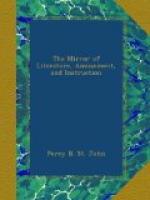“Bring your tools,” said Frantz, “and come with me.”
He led the sexton to his chamber—desired him to raise the mysterious hearthstone, and dig up the ground beneath it. This was accordingly done, and in a few minutes, with sentiments of unspeakable pity and horror, Frantz beheld the fleshless remains of two children, who apparently from the size of the bones must have been about the age and figure, when deposited there, of the little phantoms. He found also upon turning to the register, that it laid open at the very page named by the sexton; and on the very spot which the apparition of the wretched Von Weetzer had indicated by his finger, was duly entered the baptism of the murdered children; and the sexton readily turned to the entries of their birth in other parts of the volume. Frantz interred the remains of these unfortunate beings in consecrated ground—immediately quitted Steingart— resigned a preferment which had (from the singularly terrible incident thus connected with his possession of it) equally alarmed and disgusted him—married Adelinda upon his return to Leipzig—and gradually became an exemplary member of Society.
M.L.B.
* * * * *
Censure is the tax a man pays to the public for being eminent.—Swift.
* * * * *
THE NATURALIST.
* * * * *
NEST OF THE TAYLOR BIRD.
[Illustration: Nest of the Taylor Bird.]
This is one of the most interesting objects in the whole compass of Natural History. The little architect is called the Taylor Bird, Taylor Wren, or Taylor Warbler, from the art with which it makes its nest, sewing some dry leaves to a green one at the extremity of a twig, and thus forming a hollow cone, which it afterwards lines. The general construction of the nest, as well as a description of a specimen in Dr. Latham’s collection, will be found at page 180, of vol. xiii. of the MIRROR.
The Taylor Bird is only about three and a half inches in length, and weighs, it is said, three-sixteenths of an ounce; the plumage above is pale olive yellow; chin and throat yellow; breast and belly dusky white. It inhabits India, and particularly the Islands of Ceylon. The eggs are white, and not much larger than what are called ant’s eggs.[1]
In constructing the nest, the beak performs the office of drilling in the leaves the necessary holes, and passing the fibres through them with the dexterity of a tailor. Even such parts in the rear as are not sufficiently firm are sewed in like manner.
[20] Notes to Jennings’s Ornithologia, p. 324.
* * * * *
IVY.
Mr. Gilbert Burnett thus beautifully illustrates the transitorial metamorphosis of ivy:—




